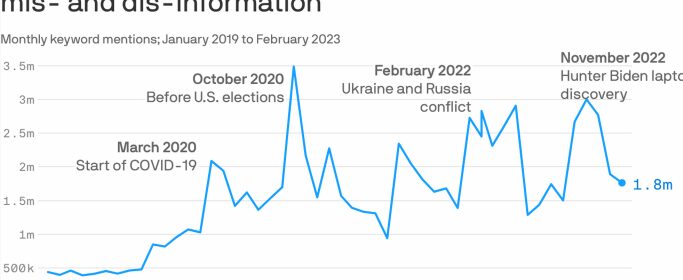The modern crisis communications playbook

In the age of social media, companies, brands and public figures are just one viral TikTok or tweet away from a full-fledged public relations crisis.
Why it matters: If communicators hope to regain control of the message and re-establish trust, their crisis management playbooks must now include strategies to combat misinformation and disinformation online.
State of play: Social media is the current battlefield for crises because it's where issues have the most potential to spin out of control.
- A recent MIT study found false news online reaches people about six times faster than the truth and falsehoods are 70% more likely to be retweeted on Twitter than the truth.
- Public chatter about mis- and disinformation continues to skyrocket, accumulating 25 million mentions — a 30% increase from last year, according to data shared by Zignal Labs.
By the numbers: While most are aware that misinformation abounds, few are prepared to address it.
- Most U.S. businesses admit they are inadequately prepared to communicate during a crisis, a recent Capterra survey found.
- 28% of businesses don’t have formal response plans and 23% have no plan at all.
- Of the leaders who have witnessed a crisis, 84% say they would increase crisis planning and 72% would broaden the scope of their communications plan.
What they're saying: Crisis plans need to be social media friendly, says Molly McPherson, a crisis communications consultant and avid TikTok user.
- "Crisis communication response, particularly as it relates to social media, has changed dramatically due to the influence of short-form video," McPherson told Axios.
- "Prior to TikTok, most social media crises were happening on Twitter and companies were combating words with words. What has changed is not only a new social media giant, but one that is fueled by younger generations who have very strong opinions and are highly engaged."
Between the lines: Just when companies and brands were getting comfortable issuing nameless, faceless statements on Twitter, a platform that doesn't allow for corporate anonymity comes along.
- TikTok's user-generated content can quickly go viral and directly impact a brand's reputation — from extreme instances like Southwest's flight meltdowns and Daily Harvest recalls to cultural head-scratchers like West Elm Caleb.
- To better manage these viral moments and push out facts, teams must evolve to meet audiences where they are with short-form video, says McPherson.
Yes, but: In some cases, a corporate response on social media can backfire by bringing more attention to the issue.
- "You have to weigh whether [the issue] is an actual risk to the company. Then you have to take a hard look at the source," crisis and issues management expert Larry Cristini told Axios. "Responding to those that don't have influence or credibility could actually raise their standing by drawing you into some engagement online."
- And if the source isn't credible, a company can still be proactive on social media "by highlighting what they do well and focusing on the positives instead of combating what's been said," Jo Robertson, author of "Executing Crisis: A C-Suite Crisis Leadership Survival Guide," told Axios.
The big picture: Misinformation can spread faster than facts, so communicators need to get ahead rather than play catch up.
According to experts Axios spoke to, here's how …
- Establish a rapid response team to monitor for misinformation during all hours. Response time is critical in the early stages of a misinformation campaign.
- Create an information hub — usually a website — for the most up-to-date, public information. This should be a reliable resource for reporters, community members, employees and shareholders.
- Find the messenger who can over-communicate, provide the public with updated information and address all inaccuracies point by point.
- Meet audiences where they are by using all platforms at your disposal — traditional media, social media,owned platforms and internal message boards or channels.
Plus, a few general crisis response tips to keep in mind …
- The only way out is through. Leadership should identify where they want things to stand once the crisis has passed. What are the goals and objectives? Work back from that.
- Live in reality by coming to terms with your role in the crisis — are you the villain or the victim? This answer should inform your actions.
- Less spin, more action. All communications following a crisis should focus on the actionable next steps — it's not just about what you're saying, but what you're doing.
- Look at the data. Data can shed light on sentiment, inform when to weigh in and prescribe where to go to reach specific audiences.
- Engage with surrogates and be proactive by reaching out to trusted journalists.
- And don't forget about employees — they are your strongest allies. Be transparent, share the facts and explain the crisis plan to them.
The bottom line: Crises and misinformation campaigns can happen across all platforms. Communicators should have a plan in place that uses all available channels and reaches hyper-targeted, engaged audiences.
Subscribe to Axios Communicators.
Source: Read Full Article

